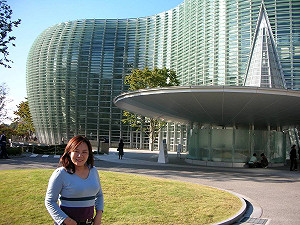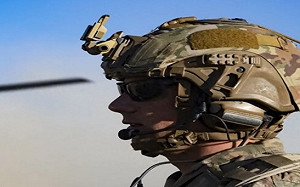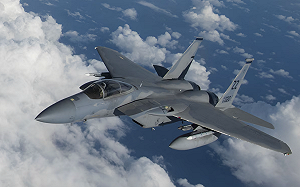漫遊太陽系(三)
林光餘譯
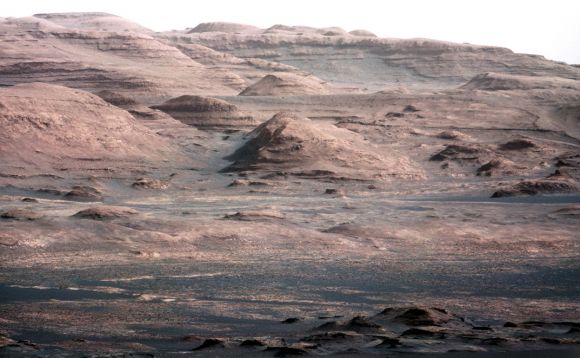
20. This image is from a test series used to characterize the 100-millimeter Mast Camera on NASA's Curiosity rover. It was taken on August 23, 2012, and looks south-southwest from the rover's landing site. The 100-millimeter Mastcam has three times better resolution than Curiosity's 34-millimeter Mastcam, though it has a narrower field of view. In the distance, there are dark dunes and then the layered rock at the base of Mount Sharp. Some haze obscures the view, but the top ridge, depicted in this image, is 10 miles (16.2 kilometers) away. Scientists enhanced the color in this version to show the Martian scene under the lighting conditions we have on Earth, which helps in analyzing the terrain.
2012年8月23日,由好奇號100mm桅柱相機對準著陸區南南西方所拍攝的測試圖。100mm桅柱相機的攝角較窄,但解析度比另一具34mm桅柱相機解析度高三倍。圖中遠方是一些暗色土丘,然後是夏普山(Mount Sharp)山腳的亂石堆。還有些霧氣阻礙了視線,但圖上方的山稜線已與好奇號相距約10哩(16.2公里)。科學家加深了這張照片色調,並以地球光線的感覺來顯示火星景象,以便利火星地形的分析。
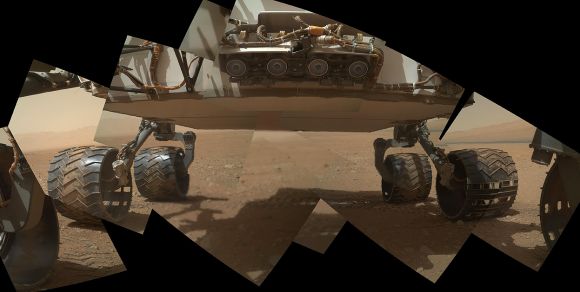
21. This view of the lower front and underbelly areas of NASA's Mars rover Curiosity combines nine images taken by the rover's Mars Hand Lens Imager (MAHLI) during the 34th Martian day, or sol, of Curiosity's work on Mars, on September 9, 2012. Curiosity's front Hazard-Avoidance cameras appear as a set of four blue eyes at the top center of the portrait. Fine-grain Martian dust can be seen adhering to the wheels, which are about 16 inches (40 centimeters) wide and 20 inches (50 centimeters) in diameter. The bottom of the rover is about 26 inches (66 centimeters) above the ground. On the horizon at the right is a portion of Mount Sharp, with dark dunes at its base. The camera is in the turret of tools at the end of Curiosity's robotic arm.
2012年9月9日是好奇號火星漫遊車著陸後第34火星日(太陽日)。本圖為好奇號於該日以其「火星手部成像儀」(Mars Hand Lens Imager)(譯注:這部儀器位於火星漫遊車自動臂前端「手掌」的位置,故名。),朝向自己正下方以及底部所拍攝的。這是一張結合九張影像而成的圖片。圖中央是好奇號的前端防撞照相機組,這套機組共有四具藍色鏡頭。好奇號車輪寬16吋 (40公分),輪徑為20吋(50公分)。圖中可見車輪黏附著細密的火星塵土,漫遊車底部則離地26吋(66公分)。在地平線右方,可見到一部分夏普山。 夏普山底部則是一些深色土丘。這具「手部照相機」安裝於好奇號自動臂端部的工具轉台架上。
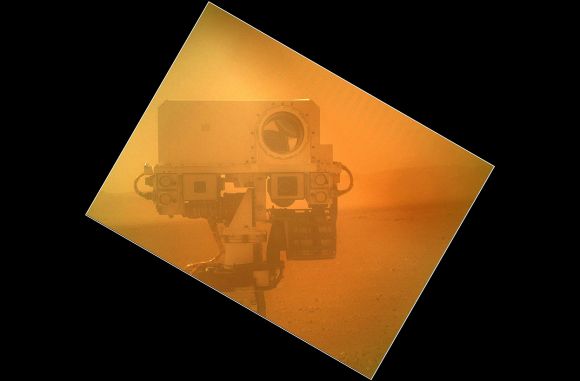
22. On Sol 32, September 7, 2012, the Curiosity rover used a camera located on its arm to obtain this self portrait. The image of the top of Curiosity's Remote Sensing Mast, showing the Mastcam and Chemcam cameras, was acquired by the Mars Hand Lens Imager (MAHLI). The angle of the frame reflects the position of the MAHLI camera on the arm when the image was taken.
2012年9月7日,好奇號登陸火星第32太陽日,好奇號以其自動臂上照相機進行自拍。這幀由「火星手部成像儀」所拍攝的圖片,顯示了好奇號遙控感應桅柱的頂部,包括桅柱照相機與化學分析照相儀(ChemCam)部分。圖片內圖像框所呈現的角度,正是自動臂「火星手部成像儀」攝取本圖片時的角度。
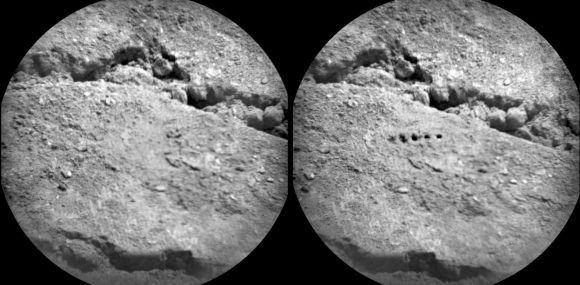
23. The Chemistry and Camera (ChemCam) instrument on NASA's Mars rover Curiosity used its laser to examine side-by-side points in a target patch of soil, leaving the marks apparent in this before-and-after comparison. The two images were taken by ChemCam's Remote Micro-Imager from a distance of about 11.5 feet (3.5 meters). The diameter of the circular field of view is about 3.1 inches (7.9 centimeters). Researchers used ChemCam to study this soil target, named "Beechey," during the 19th Martian day, or sol, of Curiosity's mission, August 25, 2012.
2012年8月25日是好奇號執行任務以來的第19火星日(太陽日)。是日,好奇號的化學分析照相儀以雷射檢測一塊目標土塊上的並列洞眼。圖片顯示目標土塊在檢測前、後的不同外觀。當時照相儀的遙控微成像儀與目標相距約11.5呎(3.5公尺)。土塊所形成的圓形視野徑寬約3.1吋(7.9公分)。這塊目標土塊已被命名為「比其」(Beechey)。
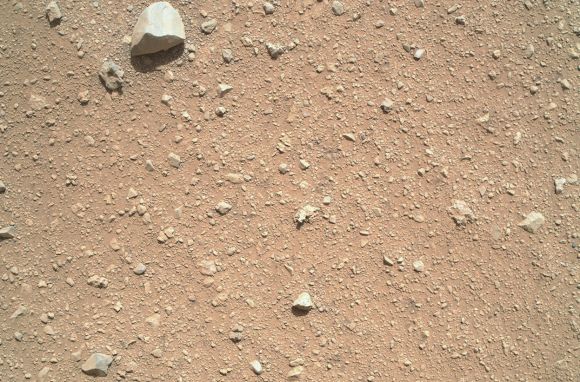
24. On September 8, 2012, Curiosity's Mars Hand Lens Imager (MAHLI) took this detailed image of Martian soil. The patch of ground shown is about 34 inches (86 centimeters) across. The size of the largest pebble, near the top of the image, is about 3 inches (8 centimeters). Notice that the ground immediately around that pebble has less dust visible (more gravel exposed) than in other parts of the image. The presence of the pebble may have affected the wind in a way that preferentially removes dust from the surface around it.
2012年9月8日,好奇號以「火星手部成像儀」(MAHLI)拍攝這張成像細密的火星地面圖。這小片土地的寬度約34吋(86公分)。圖頂端最大一塊石頭約3吋(8公分)。請注意這塊石頭周邊的塵土,比圖中其他地方少,碎石則較多。這塊石頭的存在,可能讓風更容易吹走它周邊的塵土。

25. The penny in this image is part of a camera calibration target on NASA's Mars rover Curiosity. The MAHLI camera on the rover took this and other images of the MAHLI calibration target on September 9, 2012. The penny is a nod to geologists' tradition of placing a coin or other object of known scale as a size reference in close-up photographs of rocks, and it gives the public a familiar object for perceiving size easily when it will be viewed by MAHLI on Mars. The specific coin, provided by MAHLI's principal investigator, Ken Edgett, is a 1909 "VDB" penny. That was the first year Lincoln pennies were minted and the centennial of Abraham Lincoln's birth. The VDB refers to the initials of the coin's designer, Victor D. Brenner, which are on the reverse side. The calibration target for the Mars Hand Lens Imager (MAHLI) instrument also includes a "Joe the Martian" character, color references, a metric bar graphic, and a stair-step pattern for depth calibration.
2012年9月9日,「火星手部成像儀」對準一枚硬幣與其他攝影校正點作為其攝影校正目標。地質學家在傳統上,習慣使用硬幣或已知尺寸的物體,作為石塊或岩石近距攝影時的尺寸參考物;同時,硬幣等物也容易讓一般公眾在觀賞相關圖片時了解目標物的尺寸。圖中這枚硬幣是由「火星手部成像儀」首席調查員肯‧埃格特(Ken Edgett)所提供;這是一枚1909年VDB便士。1909年是「林肯便士」出版的第一年,也是林肯百歲誕辰的一年。VDB則是硬幣設計者Victor D. Brenner名字的縮寫。「火星手部成像儀」的其他校正目標物尚包括:一塊「火星人裘歐」(Joe the Martian)的圖形(譯註:就在硬幣正上方偏左的小圖)、彩色參考物、一條公制條柱圖形,以及提供景深校正用的階梯式形物。
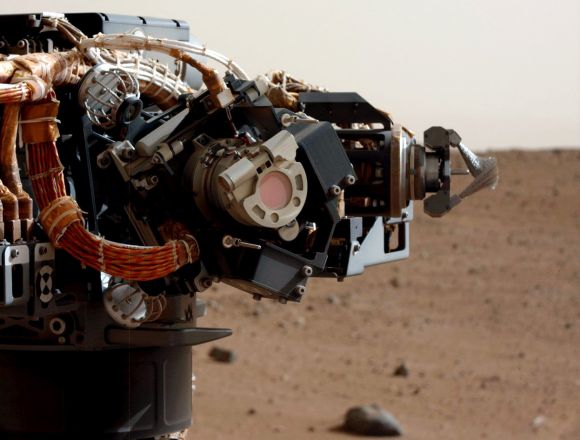
26. The left eye of the Mast Camera (Mastcam) on NASA's Mars rover Curiosity took this image of the MAHLI camera on the rover's arm, on Mars, on September 5, 2012. The image shows that MAHLI has a thin film or coating of Martian dust on it. This dust accumulated during Curiosity's final descent to the Martian surface, as the Mars Science Laboratory spacecraft's descent stage (or sky crane) engines were disrupting the surface nearby. The reddish circle near the center of the Mastcam Sol 30 image is the window of MAHLI's dust cover, with a diameter a little less than a soda can's diameter. The mechanism at the right in this image is Curiosity's dust removal tool, a motorized wire brush.
2012年9月5日是火星漫遊車好奇號登陸火星第30太陽日(Sol 30)。這一天,它的桅柱照相儀(MastCam)拍攝一張自動臂上的「手部成像儀」照片。照片顯示「手部成像儀」沾染上一層薄薄的火星灰塵。這層灰塵是好奇號在著陸最後過程中,因減速引擎(descent stage engines)的噴流衝擊到火星塵土所沾染的。圖中央的淡紅色圓環是「手部成像儀」的防塵蓋。防塵蓋直徑約略小於汽水鋁罐的直徑。圖片最右端則是好奇號的電動除塵刷。
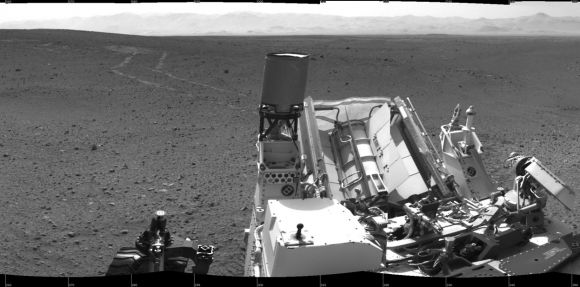
27. Tracks mark the surface of Mars, after NASA's rover Curiosity drove about 70 feet (about 21 meters) on the mission's 21st Martian day, and then took images with its Navigation Camera that were combined into this scene, which includes the fresh tracks.
漫遊車好奇號到了第21火星日時,已自最初著陸點向前移動70呎(約21公尺)。圖為其移動時所造成的車輪痕跡與好奇號在這一天所拍攝到的導航照相機機身,以及新造成的車輪痕跡。
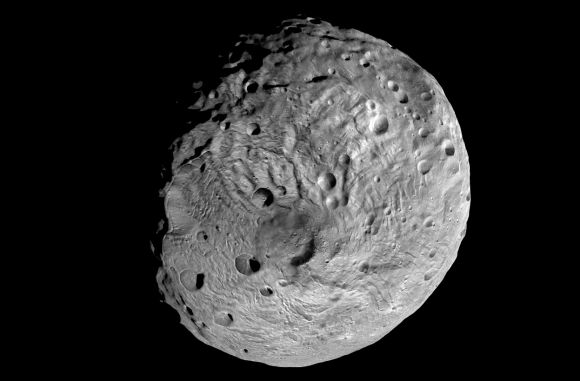
28. This undated image taken by the NASA's Dawn spacecraft shows the south pole of the giant asteroid Vesta. After spending a year examining Vesta, Dawn was poised to depart and head to another asteroid Ceres, where it will arrive in 2015.
圖為美國太空署曙光號太空探測船所拍攝的巨型小行星灶神星的南極景象。圖片未顯示拍攝日期。曙光號對灶神星進行一年探測之後,準備離開灶神星,前往另一顆小行星榖神星,預定於2015年到達。
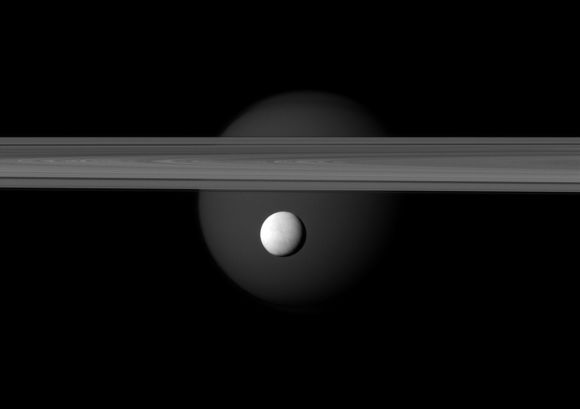
29. A brightly reflective Enceladus appears before the rings of Saturn, while the planet's larger moon Titan looms in the distance. Enceladus (313 miles, or 504 kilometers across) is in the center of the image. Titan (3,200 miles, or 5,150 kilometers across) glows faintly in the background beyond the rings, in this image acquired by NASA's Cassini spacecraft on March 12, 2012.
2012年3月12日,美國太空署卡西尼太空探測船拍攝到這張照片。圖中央是矅目的「土衛二」衛星(徑寬313哩,約504公里)。此時土衛二正出現在土星光環前,後方相當距離外,隱約可見土星較大的衛星泰坦星(土衛六)。泰坦星直徑達3,200哩,約5,150公里。
(文章僅代表作者觀點,不代表Newtalk新聞立場。)












